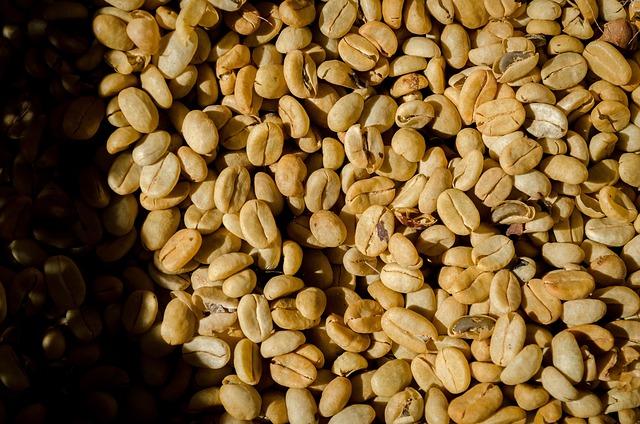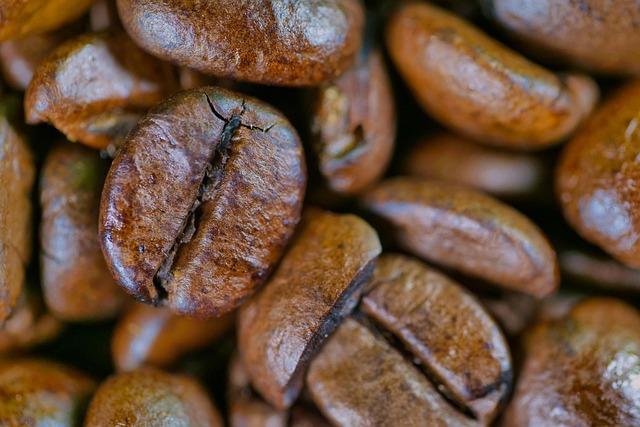Hey there, coffee lovers! 🌟 Have you ever taken a moment to appreciate that little magic bean in your cup? You know, that heavenly potion that kickstarts your day and fuels your adventures? Well, grab your favorite mug and settle in, as today we’re diving into the fascinating journey of the coffee bean plant! From its humble beginnings on lush tropical farms to the bustling cafes that serve it steaming hot, every step of its journey is packed wiht stories, science, and a sprinkle of magic.So, let’s pull back the curtain and explore what makes this beloved beverage so special. Ready to brew some knowledge? Let’s go! ☕✨
From Seed to Sip: Understanding the Life Cycle of the coffee Bean Plant
Every great cup of coffee starts with a tiny seed, nestled within the fruit of the coffee plant known as the cherry. The journey begins when these seeds are planted in rich, loamy soil, where warmth and moisture create the perfect habitat for growth. Over time, the seedlings emerge, and as they sprout, they develop thick green leaves.Some magic happens during this phase; the roots dig deep, absorbing vital nutrients and water while the plant establishes itself. It can take anywhere from 2 to 5 years for these seedlings to mature and flower, marking the transition from tender sprouts to robust plants.
Once the coffee plants are fully grown, striking clusters of flowers bloom, adorned in a delicate white hue that emits a sweet, enchanting aroma. Pollinators, like bees, play a crucial role in this next chapter, ensuring that the flowers produce the fruit we crave. Over the subsequent months, these blossoms give way to green cherries that will ripen into vibrant shades of red or yellow when they’re ready for harvest. The cycle of the coffee bean is ultimately completed through a meticulous process that includes picking, processing, roasting, and grinding - all leading to that moment when brewed perfection graces our mugs.Here’s a swift glance at some key stages:
| Stage | Description |
|---|---|
| Seedling | The seed germinates and sprouts,developing roots and leaves. |
| Flowering | White blossoms appear, attracting pollinators for fruit production. |
| Cherry Growth | Green cherries grow and change color, signaling ripeness. |
| Harvesting | Ripe cherries are carefully picked, ensuring quality. |

The Perfect Pairing: Soil, climate, and Conditions for Happy Coffee Plants
When it comes to growing the beloved coffee bean plant, the secret lies in the perfect combination of soil, climate, and conditions. Coffee plants thrive in a well-draining, nutrient-rich soil, frequently enough found in tropical regions. The ideal pH level for coffee soil ranges between 6 and 6.5, allowing for optimal nutrient absorption. Some of the best soils for coffee cultivation include:
- Volcanic Soils – Rich in minerals and perfect for flavor development.
- Clay soils – Help retain moisture while providing essential nutrients.
- Sandy Soils – Ensure proper drainage to prevent root rot.
On the climate front, coffee plants are picky but forgiving. They love a warm, consistent temperature, ideally between 60-70°F (15-24°C). Rainfall also plays a pivotal role, with about 40-100 inches of annual precipitation needed for healthy growth. To simplify the essentials, here’s a quick overview of what makes the perfect environment for coffee plants:
| Factor | Ideal Conditions |
|---|---|
| Temperature | 60-70°F (15-24°C) |
| Rainfall | 40-100 inches/year |
| Soil Type | Nutrient-rich, well-draining |

Harvest Time: tips for Picking and Processing Coffee Cherries Like a Pro
When it comes to harvesting coffee cherries, timing is everything! The best time to pick these vibrant, fruit-like pods is when they’re ripe — typically a deep red color, indicating sweetness and potential flavor profile.Here are some pro tips for the picking process:
- Know your variety: Different coffee plants produce cherries at different times. Familiarize yourself with the specific traits of the ones you’re handling.
- Look for uniformity: Aim to harvest cherries that share similar ripeness for consistent flavor when processed.
- Hand-picking preference: For specialty coffees, hand-picking ensures that only the best cherries make it into your batch.
Once you’ve gathered your cherries, it’s time to process them with care. You have a couple of methods to choose from, primarily washing and drying. Both techniques can greatly affect the final taste of your brew.For washing, remove the outer skin and mucilage by fermenting the cherries in water.Conversely, drying can be done naturally by spreading cherries under the sun, allowing the moisture to evaporate, or mechanically using a dryer.Here’s a simple table to illustrate the two methods:
| Processing Method | Key Characteristics |
|---|---|
| Washing | Clean flavor, vibrant acidity |
| Drying | Earthy flavor, complex sweetness |
Whichever method you choose, always remember that the journey from cherry to cup is an art form inspired by passion. Happy harvesting!
Brewing Brilliance: How to Turn Your Home Brew into a Coffee Shop Experience
Transforming your home brewing experience into a cozy coffee shop vibe is simpler than you might think! Start by setting the mood with ambiance-enhancing elements. Consider adding soft lighting, a few cozy seating options (think bean bags or a small café table), and maybe even some local artwork on the walls. An inviting atmosphere will not only uplift your brewing process but also create a delightful experience for friends and family visiting your home café. Don’t forget to incorporate some of your favorite playlist tunes—music can enhance the taste experience even before that first sip!
Next, focus on the brew technique that sets your coffee apart. Here’s a quick checklist to ensure every cup is sensational:
- Quality Beans: Always choose freshly roasted, high-quality coffee beans.
- Grind Fresh: Grind your beans just before brewing to preserve the flavor.
- Perfect Water: Use filtered water to avoid any unwanted flavors.
- Brewing Method: Experiment with different methods like pour-over,French press,or Aeropress for variety.
| Brewing Method | Flavor Profile | Best For |
|---|---|---|
| Pour Over | Shining and Clean | Single Origin Coffee |
| French Press | Rich and Full-bodied | Dark Roasts |
| Aeropress | Versatile & Bold | Everyday Brewing |
Q&A
Q&A: Brewing Magic: All About the Coffee Bean Plant Journey
Q: What’s the deal with coffee beans? Are they really magical?
A: Absolutely! Coffee beans have their own enchanting journey from plant to cup. They’re not just magical in flavor; they also carry stories of different cultures and histories. When you brew a cup of coffee, you’re sipping on a global experience!
Q: Okay, but where do coffee beans actually come from? Are they just found in a grocery store?
A: Great question! Coffee beans start off as cherries on a coffee tree. these trees grow primarily in warm, tropical climates—think Brazil, Colombia, and Ethiopia. Once the cherries are harvested, they’re processed to extract the beans. So, before they hit your local café, they go through quite a journey!
Q: How long does it take for a coffee tree to produce beans?
A: Patience is key in the coffee world! It typically takes about 3 to 4 years for a coffee tree to start producing cherries. After that, it can keep producing for up to 20-30 years (just think of all that caffeine!). So, every cup comes with a backstory!
Q: What’s the difference between Arabica and Robusta beans?
A: Ah, the classic rivalry! Arabica beans are known for their smooth, sweet flavors and account for about 60-70% of the world’s coffee. They thrive in higher altitudes. Conversely, robusta beans pack a punch with higher caffeine content and a more bitter taste. They’re often used in espresso blends. Both have their charm, depending on how you like your brew!
Q: How are coffee beans processed after harvesting?
A: Processing coffee beans is where the magic really happens! There are mainly two methods: the dry process and the wet process. In the dry process, the cherries are sun-dried and then hulled. in the wet process,the flesh is removed before the beans are fermented. Each method influences flavor,so it’s super vital in determining what you taste in your cup!
Q: I hear a lot about single-origin coffee. What’s that all about?
A: Single-origin coffee is like a passport stamp for your taste buds! It refers to coffee sourced from one specific location, whether it’s a single farm, region, or country. This means you can experience the unique flavors tied to that area’s soil, climate, and cultivation methods.It’s a fab way to explore what different regions have to offer—like a coffee-tasting world tour!
Q: Any tips for brewing the best cup at home?
A: You bet! First off, always start with fresh, quality beans—grind them just before brewing to lock in flavor. Pay attention to water temperature; it should be about 195-205°F (not boiling). And don’t skimp on the coffee-to-water ratio. A good rule of thumb is 1 to 2 tablespoons per 6 ounces of water. Lastly, experiment with different brewing methods to find what tickles your taste buds!
Q: What’s the future of coffee plants? Are they endangered?
A: Sadly, yes. Climate change poses a serious threat to coffee production. Changes in temperature,rainfall patterns,and pests can all affect coffee crops. Though, there’s a lot of ongoing research into enduring practices and specialty coffee farming that aim to protect both the bean and the livelihoods of farmers.
Q: Any final thoughts about our beloved coffee beans?
A: Just remember that every sip of coffee is a result of hard work,natural wonders,and a rich heritage. So next time you savor that cup of joe, take a moment to appreciate the magical journey those little beans made to get there. Happy brewing, coffee lovers!
In Summary
Thanks for tagging along on this caffeinated journey through the enchanting world of the coffee bean plant! We’ve explored everything from the lush plantations and diligent farmers who nurture these magical beans to the tantalizing brews that fuel our days. Who knew a humble little plant could transform into the rich, aromatic cup of joy we all crave?
Next time you sip your morning coffee, take a moment to appreciate the amazing journey that led to that perfect blend in your mug. From seed to sip, there’s so much love and hard work involved in bringing that tasty brew to your table. So, whether you’re a seasoned coffee connoisseur or just starting to explore the depths of your daily grind, remember that behind every cup is a story worth savoring.
So, go ahead, get curious, maybe even try your hand at your own brewing experiments! No matter how you brew it, there’s a whole world waiting to be discovered in each cup. Until next time, keep sipping, exploring, and finding the magic in your favorite brew. Cheers! ☕✨






